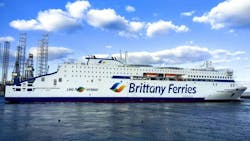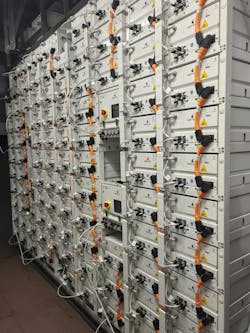Hybrid-Electric Ferries Lead the Greening of Marine Transport
What you’ll learn:
- Hybrid-electric propulsion systems are helping marine operators comply with stringent environmental regulations while improving operating margins.
- Capable of transporting 1,300 passengers and a mix of cars and trucks, these ferries are already in service throughout Europe.
- The propulsion system’s modular architecture will enable future upgrades to support all-electric operation during longer voyages.
With the acquisition of its fifth hybrid-electric deep-water ferry, Britanny Ferries leads a growing number of marine transport operators embracing battery-electric and hybrid-electric propulsion systems. Besides significantly reducing their fleets’ carbon footprints, the first generation of electrified craft has demonstrated significant savings in operating costs.
The latest addition to Brittany Ferries’ fleet is the Guillaume de Normandie, No. 12, in a series of 15 E-Flexer class vessels produced by the Chinese shipyard CMI Jinling (Weihai). It joins the other four E-Flexer vessels presently in service with the fleet. The E-Flexer series is based on a basic concept, featuring a highly flexible design that can be tailored to customers' needs.
Specifications for a typical E-Flexer vessel include:
- Length: 194.7 m, draught: 6.5 m, beam: 27.8 m
- Capacity: 1,300 passengers and 2,410 lane meters, of which 176 lane meters are intended for automobiles
- Passenger cabins: 222 distributed over four decks
- Top speed: 23 knots (17.5 knots on batteries only)
The ship's engines can be powered by marine diesel (MGO), liquefied natural gas (LNG), biodiesel, or biogas, as well as the market's largest battery-hybrid package capable of storing 12 MWh. The PTI/PTO system with the battery power function can be used for propulsion at sea or maneuvering in port.
The Guillaume de Normandie is also equipped with a shore connection that has an output of 8 MW for high-speed charging of the batteries. This enables a completely fossil-free stay when in port. With the installed battery capacity, the vessel can operate at speeds of up to 17.5 knots on batteries alone.
The system is scalable, which means that in the future, the Guillaume de Normandie can operate entirely on batteries or on a combination of different fossil fuels.
Next in This Issue of PowerBites
More PowerBites
About the Author
Lee Goldberg
Contributing Editor
Lee Goldberg is a self-identified “Recovering Engineer,” Maker/Hacker, Green-Tech Maven, Aviator, Gadfly, and Geek Dad. He spent the first 18 years of his career helping design microprocessors, embedded systems, renewable energy applications, and the occasional interplanetary spacecraft. After trading his ‘scope and soldering iron for a keyboard and a second career as a tech journalist, he’s spent the next two decades at several print and online engineering publications.
Lee’s current focus is power electronics, especially the technologies involved with energy efficiency, energy management, and renewable energy. This dovetails with his coverage of sustainable technologies and various environmental and social issues within the engineering community that he began in 1996. Lee also covers 3D printers, open-source hardware, and other Maker/Hacker technologies.
Lee holds a BSEE in Electrical Engineering from Thomas Edison College, and participated in a colloquium on technology, society, and the environment at Goddard College’s Institute for Social Ecology. His book, “Green Electronics/Green Bottom Line - A Commonsense Guide To Environmentally Responsible Engineering and Management,” was published by Newnes Press.
Lee, his wife Catherine, and his daughter Anwyn currently reside in the outskirts of Princeton N.J., where they masquerade as a typical suburban family.
Lee also writes the regular PowerBites series.






